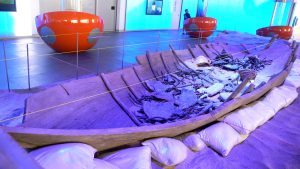 ©ARQVA
©ARQVA
En 1988, un equipo de arqueólogos del Museo y Centro Nacional de Investigaciones Arqueológicas Subacuáticas (MNAM-CNIAS) localizaron los restos del pecio fenicio Mazarrón 1. En 1993 se puso en marcha el “Proyecto Nave Fenicia”, que duró hasta 1995 y fue liderado por el Director del Museo, Iván Negueruela. El objetivo del proyecto era prospectar la bahía de Mazarrón, documentar y extraer los restos del Mazarrón 1. El barco apareció fragmentado por completo, conservándose únicamente la quilla (3.98 m), restos de cuatro cuadernas unidas a nueve fragmentos de tracas y parte de una de las bordas. La quilla fue elaborada con ciprés, las tracas de pino carrasco, las cuadernas de higuera y las espigas y clavijas, de olivo. Se encuentra fechado en la segunda mitad del siglo VII a.C.
En 1995 se localizó un segundo pecio (Mazarrón 2) en la Playa de a Isla en Mazarrón (Murcia). Se encontraba conservado casi al completo con el cargamento. Debido a que el equipo de investigadores estaba trabajando en el proyecto del Mazarrón 1, se volvió a enterrar con sedimento y se protegió con una estructura metálica. Entre octubre de 1999 y enero de 2001, se realizó la extracción y documentación del cargamento de Mazarrón 2, que estaba formado por lingotes de mineral de plomo, un ánfora, un molino de mano, una espuerta de esparto con asa de madera, restos de cabos de esparto, abarrote para la estiba y protección del caso, o su ancla, de manera y plomo.
El descubrimiento de este segundo barco permitió documentar por primera vez la vía marítima de la explotación del metal que los fenicios practicaban en la península ibérica. Además, también permitió conocer la construcción naval, la vida a bordo, el sistema de estibado y abarrotado y el uso de anclas construidas más antiguo que se conoce. Este barco está igualmente fechado de la segunda mitad del siglo VII a.C. Actualmente, el pecio se encuentra in situ y protegido por un armazón de protección. Todos los materiales extraídos se encuentran en el Museo Nacional de Arqueología Subacuática de Cartagena.
__
PHOENICIAN SHIPS OF MAZARRÓN
In 1988, a team of archaeologists from the Museo y Centro Nacional de Investigaciones Arqueológicas Subacuáticas (MNAM-CNIAS) located the remains of the Phoenician shipwreck Mazarrón 1. In 1993 the “Nave Fenicia Project” was launched, which lasted until 1995 and was led by the Director of the Museum, Iván Negueruela. The objective of the project was to prospect the bay of Mazarrón, document and extract the remains of the Mazarrón 1. The ship was completely fragmented, preserving only the keel (3.98 m), the remains of four frames joined to nine fragments of strakes and part of one of the gunwales. The keel was made of cypress, the spars of Aleppo pine, the frames of fig tree, and the pegs and pegs of olive tree. It is dated to the second half of the 7th century BC.
In 1995 a second wreck (Mazarrón 2) was located in Playa de a Isla in Mazarrón (Murcia). It was almost completely preserved with the cargo. Because the research team was working on the Mazarrón 1 project, it was reburied with sediment and protected with a metal structure. Between October 1999 and January 2001, the extraction and documentation of the Mazarrón 2 cargo was carried out, which consisted of lead ore ingots, an amphora, a hand mill, an esparto grass basket with a wooden handle, the remains of esparto grass ropes, stowage and protection gear for the case, or its anchor, and lead.
The discovery of this second ship allowed to document for the first time the maritime way of the exploitation of the metal that the Phoenicians practiced in the Iberian Peninsula. In addition, it also made it possible to know the shipbuilding, the life on board, the stowage and crowding system and the oldest known use of built anchors. This ship is also dated to the second half of the 7th century BC. The wreck is currently in situ and protected by a protective shell. All the extracted materials are housed in the National Museum of Underwater Archaeology in Cartagena.
__

